Pyrography
Pyrography or pyrogravure is the free handed art of decorating wood or other materials with burn marks resulting from the controlled application of a heated object such as a poker. It is also known as pokerwork or wood burning.
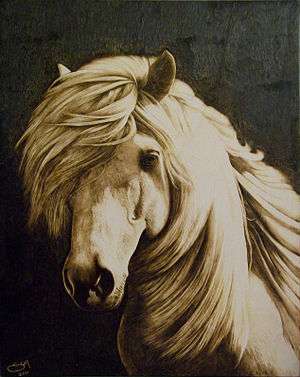
The term means "writing with fire", from the Greek pur (fire) and graphos (writing).[1] It can be practiced using specialized modern pyrography tools, or using a metal implement heated in a fire, or even sunlight concentrated with a magnifying lens. "Pyrography dates from the 17th century and reached its highest standard in the 19th century. In its crude form it is pokerwork."[2]
A large range of tones and shades can be achieved. Varying the type of tip used, the temperature, or the way the iron is applied to the material all create different effects. After the design is burned in, wooden objects are often coloured. Light-coloured hardwoods such as sycamore, basswood, beech and birch are most commonly used, as their fine grain is not obtrusive. However, other woods, such as maple, pine or oak, are also used. Pyrography is also applied to leather items, using the same hot-iron technique. Leather lends itself to bold designs, and also allows very subtle shading to be achieved. Specialist vegetable-tanned leather must be used for pyrography (as modern tanning methods leave chemicals in the leather which are toxic when burned), typically in light colours for good contrast.
Pyrography is also popular among gourd crafters and artists, where designs are burned onto the exterior of a dried hard-shell gourd.
History
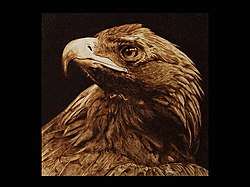
The process has been practiced by a number of cultures including the Egyptians and some African tribes since the dawn of recorded history. Pyrographer Robert Boyer hypothesizes that the art form dates back to prehistory when early humans created designs using the charred remains of their fires.[3] It was known in China from the time of the Han dynasty, where it was known as "Fire Needle Embroidery".[4] During the Victorian era, the invention of pyrography machines sparked a widespread interest in the craft, and it was at this time that the term "pyrography" was coined (previously the name "pokerwork" had been most widely used)[5] In the late 19th century, a Melbourne architect by the name of Alfred Smart discovered that water-based paint could be applied hot to wood by pumping benzoline fumes through a heated hollow platinum pencil.[6] This improved the pokerwork process by allowing the addition of tinting and shading that were previously impossible. In the early 20th century, the development of the electric pyrographic hot wire wood etching machine further automated the pokerwork process, and Art Nouveau pyrographic gloveboxes and other works were popular in that era. Pyrography is a traditional folk art in many parts of Europe, including Romania, Poland, Hungary, and Flanders, as well as Argentina and other areas in South America.
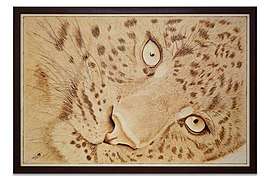
Equipment
Traditional pyrography can be performed using any heated metal implement. Modern pyrography machines exist, and can be divided into three main categories.
Solid-point burners
Solid-point burners are similar in design to a soldering iron. They have a solid brass tip which is heated by an electrical element, and operate at a fixed temperature.
Wire-nib burners
Wire-nib burners have variable temperature controls. The writing nib is heated by an electric current passing directly through it. Some models have interchangeable nibs to allow for different effects.[7]
Laser cutters
Laser cutters can be set to scorch the material instead of cutting all the way through it. Many laser cutters provide software facilities to import image files and transfer them onto a sheet of wood. Some laser systems are sufficiently sensitive to perform pyrography on thin card or even paper.
Woods
Woods differ in hardness, grain, figure, texture, color, and other physical characteristics.[8] Hardness: All woods can be classified into hard or soft. Usually softwoods are from coniferous (needle-leaved) trees. You may be aware of a little bit of resin oozing and also, a slight turpentine smell when you burn on softwood.
Hardwoods are from broad-leaved trees. These hardwood trees can be classified into two distinct growing seasons each year (hot and cold season or a wet and dry season) such as:
- Earlywood: normally lighter in color and weight and only moderately strong
- Latewood: usually heavier, darker, and much stronger.
Softwood will burn faster than a hardwood does. It does not require very hot temperature to burn as do the hardwoods.
Grain: Grain is the direction of the fibrous elements of the wood cells. This is important to sand with the grain. Also the grain can cause deviation from its intended path with use of woodturning pen unless you apply more pressure and burn slower on the grain.
Figure: This is the natural design, or pattern, that you can see on the cut surface of the wood. The figure present on the wood should always be taken into consideration when you are planning your woodburned design.
Texture: There is a texture on the surface of that wood that feels either coarse or fine, even or uneven.
As a beginning woodburner, avoid using very fine or intricate designs on uneven, coarse-textured wood. Softwoods are more apt to be fine or moderately coarse-textured. With some textures it may mean that you will have to compensate when burning it – going slower on the harder summerwood, faster and with a lighter touch on the softer springwood to create an even burn overall.
Color: Woodburning should be mainly used to enhance the natural beauty of a wooden project, so do not always hide a beautiful figure, grain, luster, or color if it is present.
Safety
The main hazard to be wary of is the extremely fine wood dust when sanding the wood or in some cases the pitch/sap or resin that emits harmful fumes when burning. All wood dust is hazardous & can cause respiratory problems if you do not wear a mask, some more than others & should be avoided. You should always wear a quality dust mask/respirator while power carving, and use a good dust collection system to avoid a lifetime injury to your lungs. These recommendations really are not just for power carving or sanding, but they should be used for burning as well. Remember:
- DO NOT burn on pressure-treated wood. It is treated with chemicals that, although safely bound in the wood fibers for construction purposes, are inherently dangerous to woodworkers and woodburners.
- DO NOT burn on any type of treated wood: Chemically treated, stained, painted, sealed with a finish, etc. If you must use this type of wood be sure that you have thoroughly sanded it to remove all traces and are burning on bare wood.[9]
Prepared Wood, Medium Density Fibreboard (MDF), man made boards and plywood should never really ever be burned on for several reasons. Prepared wood usually has been chemically treated and burning on it will release toxins into the air. MDF is made out of toxic materials and may cause cancer and other health issues. Man-made boards and such also have layers of glue that releases toxins that may not cause immediate harm but impact one later on in life. Regardless of what you decide, it is always important to work in a well ventilated room with a running fan to encourage the circulation of fresh oxygen and to remove the lingering smoke.[10]
Gallery
- Pyrography artwork of the Mona Lisa
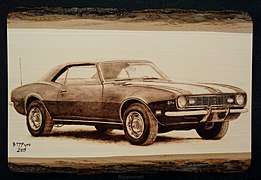 1968 Chevrolet Camaro Z/28 Pyrography by BTJPyro.com
1968 Chevrolet Camaro Z/28 Pyrography by BTJPyro.com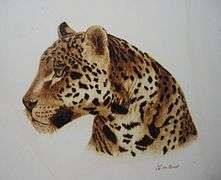 Artist: José Luis San Román
Artist: José Luis San Román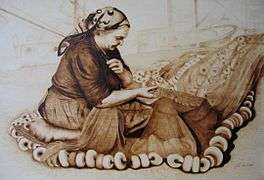 Artist: José Luis San Román
Artist: José Luis San Román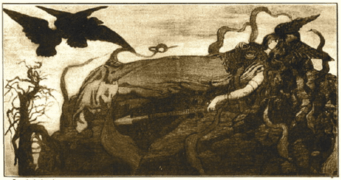 Margaret Fernie Eaton, Brunhilde Asleep, 1902
Margaret Fernie Eaton, Brunhilde Asleep, 1902 Pyrographic Leopard
Pyrographic Leopard
References
- Marianne Podgorski; Before You Pick Up That Nib: Wood Burning 101, p7 ISBN 978-0-557-05114-4
- "Pyrography." Brewer's Dictionary of Phrase and Fable. London: Chambers Harrap, 2012. Credo Reference. Web. 2 Mar 2015.
- Boyer, R; The Amazing Art of Pyrography, Evanston 1993, ISBN 978-1-879260-12-2
- China Culture - pyrography Archived 6 September 2011 at the Wayback Machine
- "Walkabout Crafts - pyrography". Archived from the original on 4 October 2013. Retrieved 15 September 2011.
- Carter, Julie; With Mellow Shades and Character Made: The Richness of Australian Pokerwork in Carter's Antiques and Collectables Magazine, Sept 2000
- Walters, S; Pyrography Workbook: A Complete Guide to the Art of Woodburning Fox Chapel 2005 p13-14 ISBN 978-1-56523-258-7
- Donohue, Nanette. "Woodburning Project & Pattern Treasury: Create Your Own Pyrography Art With 70 Mix-And-Match Designs." Library Journal 137.4 (2012): 96. Academic Search Complete. Web. 2 Dec. 2015.
- "Pyrography Materials and Safety Precautions". www.sawdustconnection.com. Archived from the original on 23 November 2017. Retrieved 19 October 2015.
- "Lesson 2: A word about safety in Pyrography". The Art of Handmade. Archived from the original on 15 August 2015. Retrieved 19 October 2015.
External links
| Wikimedia Commons has media related to Pyrography. |
- Malek Parvaneh - excellence in pyrography
- Pyrography School - showing how it's done
- Pyrography.net
- Pyrography tips and techniques
- Draw with Fire. The Art of Pyrography Stefania Mante
- Davide Della Noce pyrography
- Giuseppe Apollonio
- - Etsuko Ichikawa, using molten glass
- - Michael Turley Pyrographic Portraits on Reclaimed Wood
- Giusy Busco pyrography art
- Pyrography 101 Tutorial's by Nedra Denison